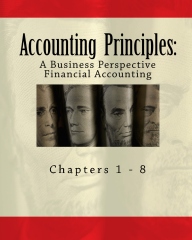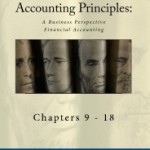 480+ MULTIPLE CHOICE AND T/F TEST QUESTIONS COVERING BOTH VOLUMES (Chapters 2 – 18). More details at Textbook Equity’s Tests Online.
480+ MULTIPLE CHOICE AND T/F TEST QUESTIONS COVERING BOTH VOLUMES (Chapters 2 – 18). More details at Textbook Equity’s Tests Online.
Order Printed Copies (Chapters 1 – 8) Buy via Amazon.com $39.95
Download Here (Chapters 1 – 8 ) (free pdf, 4.9MB, 433 pages)
ERRATA: Download The Limited, Inc. Financial Statements used in the textbook exercises. It is already included in the current PDF textbook above.
•View Textbook Reputation, Original Author Information, Acknowledgments
Related Texts by the same authors: Vol 2, Chapters 9 – 18 and Managerial Accounting
Publication Date: Apr 14 2011
ISBN/EAN13: 1461088186 / 9781461088189
Page Count: 434
Binding Type: US Trade Paper
Trim Size: 8″ x 10″
Language: English
Color: Black and White
Related Categories: Business & Economics / Accounting / Managerial
Key Features
√ Demonstration problems
√ Solutions to demonstration problems
√ Key terms
√ Self-tests
Table of Contents
1 The Accounting Environment
Learning objectives
Accounting Defined
Employment opportunities in accounting
Financial accounting versus managerial accounting
Development of financial accounting standards
Ethical behavior of accountants
Critical thinking and communication skills
Internet skills
How to study the chapters in this text
2 Accounting and its use in business decisions
Learning objectives
A career as an entrepreneur
Forms of business organizations
Types of activities performed by business organizations
Financial statements of business organizations
The financial accounting process
Underlying assumptions or concepts
Transactions affecting only the balance sheet
Transactions affecting the income statement and/or balance sheet
Summary of balance sheet and income statement transactions
Dividends paid to owners (stockholders)
Analyzing and using the financial results—the equity ratio
Understanding the learning objectives
Appendix: A comparison of corporate accounting with accounting for a sole
proprietorship and a partnership
Demonstration problem
Solution to demonstration problem
Key terms
Self-test
3 Recording business transactions
Learning objectives
Salary potential of accountants
The account and rules of debit and credit
Recording changes in assets, liabilities, and stockholders’ equity
The accounting cycle
The journal
The ledger
The accounting process in operation
The use of ledger accounts
Analyzing and using the financial results— Horizontal and vertical analyses
Key terms
Self-test
4 Adjustments for financial reporting
Learning objectives
A career as a tax specialist
Cash versus accrual basis accounting
The need for adjusting entries
Classes and types of adjusting entries
Adjustments for deferred items
Adjustments for accrued items
Effects of failing to prepare adjusting entries
Analyzing and using the financial results—trend percentages
Understanding the learning objectives
5 Completing the accounting cycle
Learning objectives
A career in information systems
The accounting cycle summarized
The work sheet
Preparing financial statements from the work sheet
Journalizing adjusting entries
The closing process
Accounting systems: From manual to computerized
A classified balance sheet
Analyzing and using the financial results — the current ratio
Understanding the learning objectives
6 Accounting theory
Learning objectives
A career as an accounting professor
Traditional accounting theory
Underlying assumptions or concepts
Other basic concepts
The measurement process in accounting
The major principles
Modifying conventions (or constraints)
The financial accounting standards board’s conceptual framework project
Objectives of financial reporting
Qualitative characteristics
The basic elements of financial statements
Recognition and measurement in financial statements
Summary of significant accounting policies
Significant accounting policies
Understanding the learning objectives
7 Introduction to inventories and the classified income statement
Learning objective
A career as a CEO
Sales revenues
Cost of goods sold
Classified income statement
Analyzing and using the financial results—Gross margin percentage
Understanding the learning objectives
Appendix: The work sheet for a merchandising company
Key terms
Self-test
8 Measuring and reporting inventories
Learning objectives
Choosing an accounting career
Inventories and cost of goods sold
Importance of proper inventory valuation
Determining inventory cost
Departures from cost basis of inventory measurement
Analyzing and using financial results—inventory turnover ratio
Understanding the learning objectives
Alphabetical Index
Alphabetical Index
academic accountants
accounting cycle
Accounting Education Change Commission
accounting equation
Accounting period
Accounting Principles Board (APB)
Accounting Review
Accounting Review The
accounting system
accounting theory
Accounting year
Accounts Payable
Accounts Receivable
accrual basis
Accrual basis of accounting
accrued assets and liabilities
Accrued revenues and expenses
Accumulated amortization
Accumulated Depreciation
Accumulated Depreciation account
Adjunct account
adjusting entries
administrative expenses
AECC
AICPA
Allowances account
American Accounting Association
assets
balance sheet
bias
bonds payable
book value
Buildings
Business emphasis
business entity concept
Business transactions
calendar year
capital stock
cash basis of accounting
cash discount
cash equivalents
Certified Internal Auditor
Certified Management Accountants
Certified Public Accountant
Chain discount
Chart of accounts
CIA
classified balance sheet
classified income statement
closing process
Comparability
completed-contract method
Compound journal entry
Conservatism
Consigned goods
consistency
Construction in progress
continuity
contra asset account
Copyright
Corporation
cost
cost of goods available for sale
cost of goods sold
cost principle
Cost-benefit consideration
CPA
Credit balance
Creditors and lenders
Cross-indexing
current assets
Current liabilities
current ratio
Curriculum concerns
customers
Debit balance
deferred items
Delivery Expense
Depreciable amount
Depreciable asset
depreciation accounting
Depreciation expense
depreciation formula
Dividend
Dividends payable
Double entry procedure
Earning principle
Edwards
Employees and their unions
End of Volume Chapters
entity
entrepreneur
equities
equity ratio
estimated useful life
ethical behavior
ethics
exchange-price
exchange-price (or cost) principle
expenses
Exposure Drafts
FASB
Fearless copy print remix(tm)
feedback value
Financial Accounting
Financial Accounting Standards Board
Financial Analysts Federation
Financial Executives Institute
financial reporting objectives
financial statements
fiscal year
FOB destination
FOB shipping point
for Volume Chapters and all of Volume
freight collect
freight prepaid
full disclosure principle
GAAP
Gain and loss recognition principle
Gains
GASB
general public
generally accepted accounting principles
Global Text Project
Going-concern
goodwill
Governmental Accounting Standards Board
Governmental units
gross margin
gross margin percentage
gross profit
gross selling price
Hermanson
historical cost
Horizontal analysis
IASB
IASC
IFRS
Income from operations
income statement
Income Summary account
Income taxes payable
installment basis
Institute of Certified Management Accountants
Institute of Chartered Accountants of India
Institute of Management Accountants
intangible assets
Interest Payable
Interest Receivable
Internal Auditors
International Accounting Standards
International Financial Reporting Standards
invoice
invoice price
Journal entry
Journal of Accountancy
Land
Leasehold improvements
Leaseholds
Ledger
liabilities
liquidation
long-term assets
Long-term investment
Long-term liabilities
losses
Maher
management advisory
Manufacturers
manufacturing companies
marketable securities
matching principle
Materiality
McCubbrey
Merchandise in transit
Merchandise Inventory
Merchandising companies
Modifying conventions
Money measurement
Net cost of purchases
net income
net purchases
net sales
neutrality
Nominal accounts
Non-operating expenses
Non-operating revenues
Note
notes payable
Objectives and overall approach of the eighth edition
office equipment
office furniture
operating cycle
Operating expenses
Operating revenues
Owners and prospective owners
Pacioli
Paid-in Capital
partnership
Passage of title
Patent
Pedagogy
percentage-of-completion
Period costs
periodic inventory procedure
Periodicity
Permanent accounts
perpetual inventory procedure
Philosophy and purpose
physical inventory
post-closing trial balance
Predictive value
Prepaid expense
prepaid expenses
private sector
Product costs
profitability
Property plant and equipment
Purchase bound textbooks and download free PDFs
purchase discount
Purchase Discounts account
Purchase returns
Purchases account
qualitative characteristics
real accounts
Realization principle
Relevance
reliability
representational faithfulness
retailers
Retained Earnings
retained earnings
revenue recognition principle
revenues
revenues received in advance
Salaries Payable
sales allowance
sales discount
Sales Discounts account
Sales Return
Sales returns
scrap value
SEC
Securities and Exchange Act of
Securities and Exchange Commission
selling expenses
service companies
service potential
shareholders
Simple journal entry
Single proprietorship
solvency
stable dollar assumption
statement of cash flows
statement of retained earnings
stockholders
stockholders’ equity
stockholders’ equity
straight-line
Summa de Arithmetica
summary of transactions
T-account
Tax services
Taxes withheld from employees
Temporary accounts
Textbook Equity
time periods
Timeliness
Trade Discount
transaction
Transportation In account
unclassified balance sheet
unclassified income statement
unearned revenue
Unearned revenues
verifiability
wholesalers
work sheet
www.textbookequity.org

 •
•